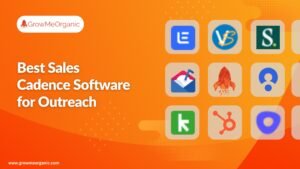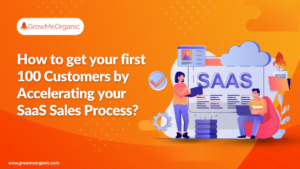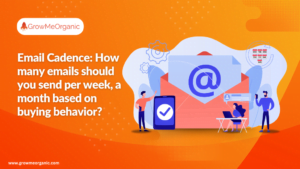I’ve seen countless sales professionals struggle with email outreach. They send generic templates, hoping something sticks.
But here’s what I’ve learned after a decade in sales leadership: the key to closing deals through email lies in the art of asking the right questions.
That’s where SPIN Selling comes in.
SPIN Selling isn’t just another sales methodology—it’s a proven framework that transforms how we engage with prospects. It focuses on four types of questions:
- Situation questions to understand context
- Problem questions to uncover challenges
- Implication questions to explore consequences
- Need-payoff questions to highlight the value
When applied to email outreach, SPIN Selling helps you:
- Cut through inbox noise with targeted messages
- Build meaningful connections with prospects
- Guide conversations toward natural closings
- Increase response rates significantly
In this guide, I’ll show you how to adapt SPIN Selling principles for email outreach. You’ll learn practical strategies to craft personalized messages that resonate with your prospects and drive results.
Whether you’re a seasoned sales professional or just starting, these techniques will help you transform your email outreach from generic to genuinely effective.
Understanding SPIN Selling
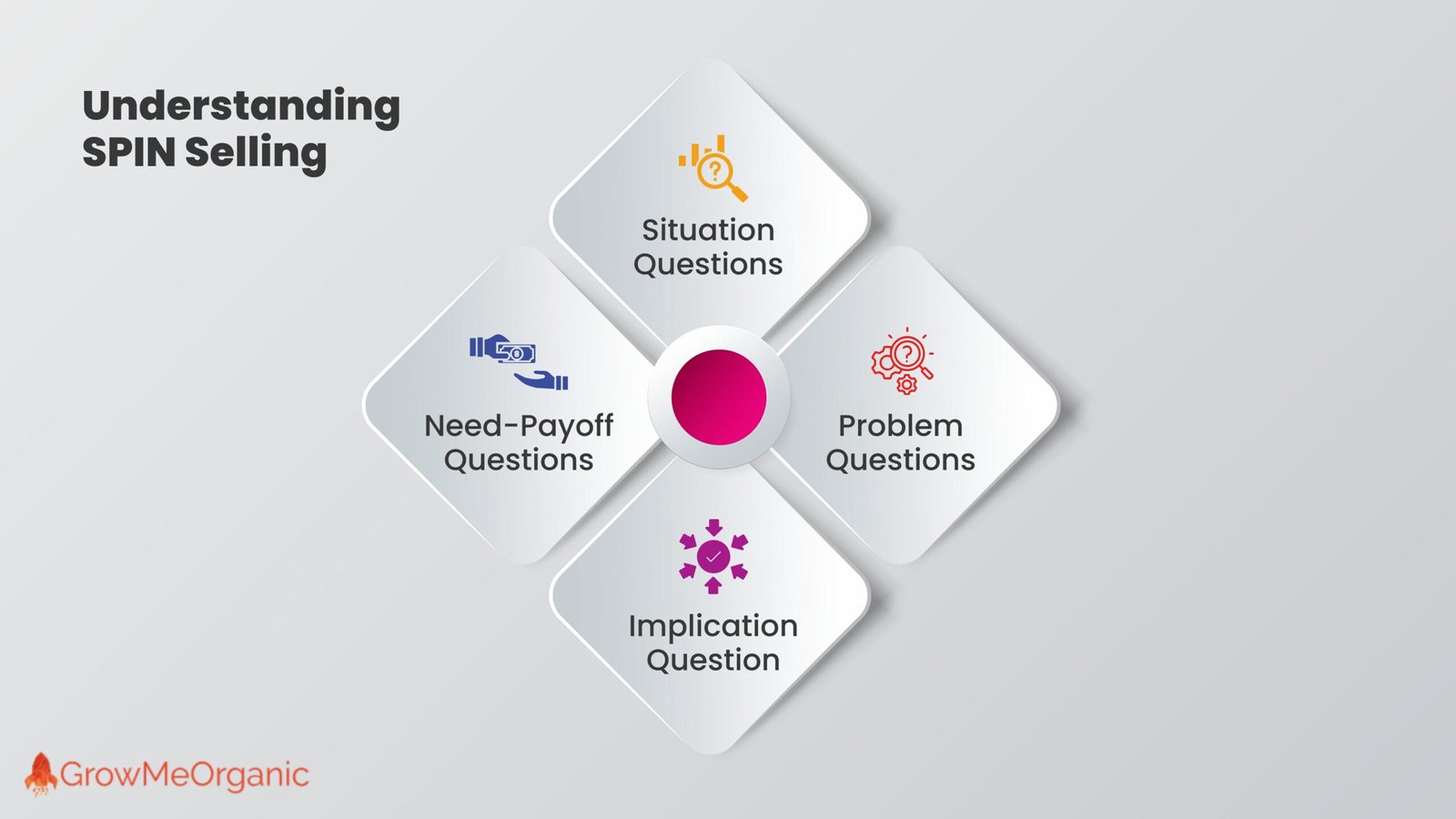
SPIN Selling isn’t just another sales methodology – it’s a game-changer backed by 12 years of research and 35,000 sales calls. When Neil Rackham developed this approach in the 1980s, he changed the way we think about sales conversations.
Let’s break down the SPIN framework:
1. Situation Questions
These questions are designed to gather information about the prospect’s current situation. By asking about their existing processes, systems, and business context, you can gain a better understanding of their needs.
2. Problem Questions
Once you have a clear picture of the prospect’s situation, it’s time to uncover any difficulties or dissatisfaction they may be experiencing. These questions should focus on identifying pain points and challenges that are hindering their progress.
3. Implication Questions
Now that you know what problems the prospect is facing, it’s important to dig deeper into the effects of these issues. Implication questions help prospects realize the cost of inaction and build urgency by revealing ripple effects caused by their problems.
4. Need-Payoff Questions
Finally, you want to guide prospects toward articulating their needs and visualizing the value of your solution. Need-payoff questions encourage them to convince themselves of the benefits your product or service can bring.
Here’s what makes SPIN Selling different: It’s not about pushing products – it’s about pulling out needs.
Think of it as detective work. You’re investigating your prospect’s situation, uncovering problems they might not even realize they have, and helping them see the full impact of these issues.
The beauty of SPIN lies in its psychological foundation. Each question type builds upon the previous one, creating a natural progression that leads prospects to their conclusions. It’s like laying breadcrumbs that guide them to understand why they need your solution.
I’ve seen sales teams transform their results by mastering these question types.
A client of mine increased their close rate by 35% after implementing SPIN Selling in their outreach strategy. The key? They stopped talking at prospects and started having meaningful conversations with them.
The SPIN framework works particularly well for complex B2B sales where:
- The buying cycle is longer
- Multiple stakeholders are involved
- Solutions require significant investment
- Problems aren’t immediately obvious
When you’re dealing with high-stakes sales, surface-level conversations won’t cut it. SPIN gives you the tools to dig deeper and create value in every interaction.
The Psychology Behind SPIN Selling
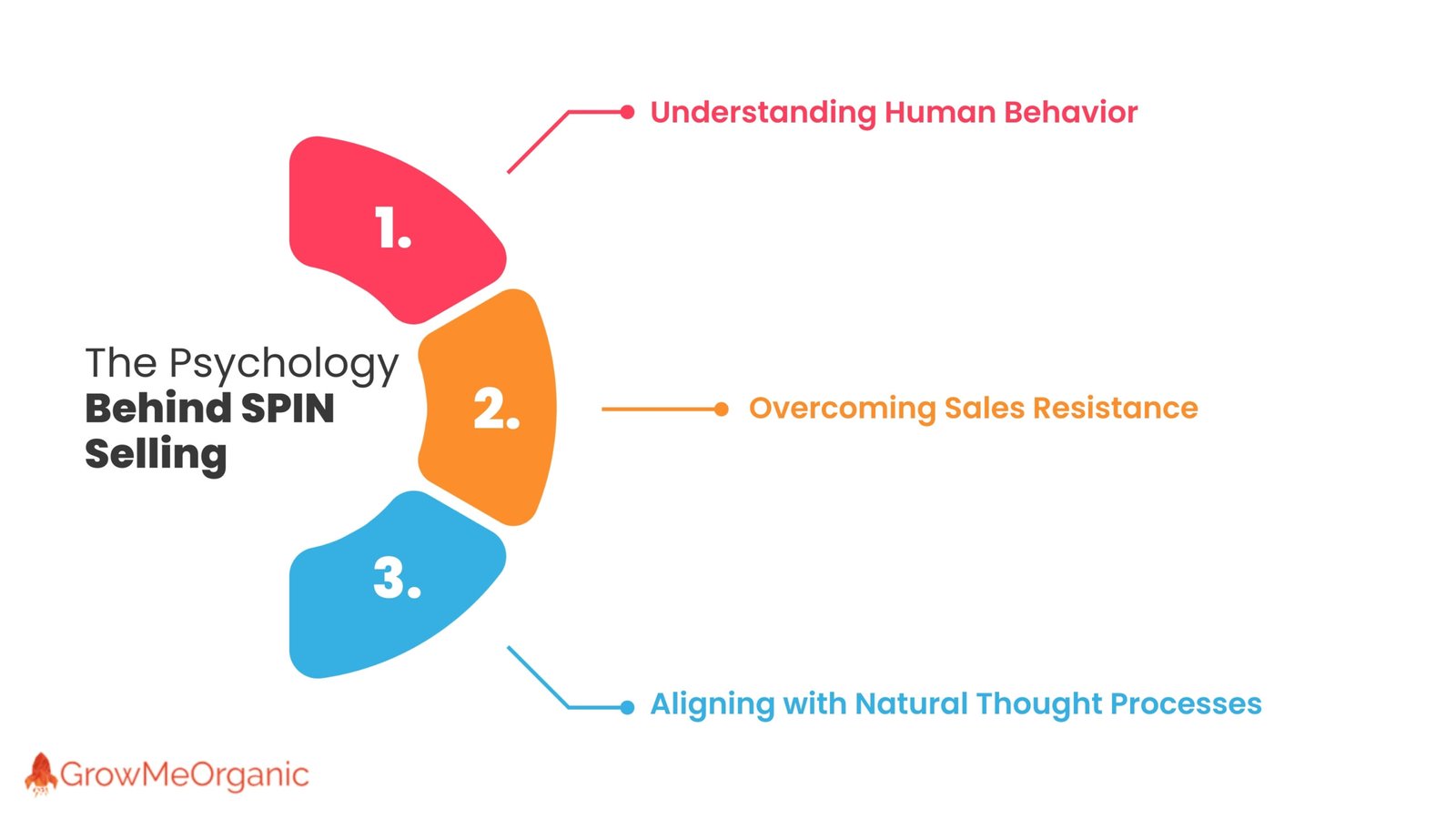
SPIN Selling is based on important psychological principles that influence how humans make decisions.
This method works in harmony with the way our brains understand information and decide what to buy.
Understanding Human Behavior
The human brain reacts most strongly to personal pain points. When we face discomfort or difficulties, our instinct is to find solutions.
SPIN Selling takes advantage of this psychological trigger by:
- Building Self-Discovery: Instead of telling potential customers what they need, SPIN questions help them discover their challenges.
- Creating Emotional Investment: As potential customers express their problems, they become emotionally invested in finding a solution.
- Activating Loss Aversion: Implication questions tap into our natural tendency to avoid losses more than we seek gains.
Overcoming Sales Resistance
The methodology also addresses our brain’s natural resistance to being sold to. Traditional sales methods often make people defensive, but SPIN’s consultative approach:
“The best sales conversations feel like collaborative problem-solving sessions, not sales pitches”
This consultative approach has three main psychological effects:
- Reduced Resistance: Potential customers feel heard and understood instead of pressured.
- Increased Trust: The focus on understanding builds credibility and rapport.
- Enhanced Motivation: Needs discovered by oneself create stronger motivation to buy than solutions imposed by others.
Aligning with Natural Thought Processes
The order of SPIN questions reflects how people naturally think:
- Situation → establishes context
- Problem → identifies pain points
- Implication → builds urgency
- Need-Payoff → creates the desire for a solution
This alignment with human thought processes explains why interactions based on SPIN result in higher close rates and better customer satisfaction.
The approach respects how individuals think, process information, and make decisions.
The Benefits of SPIN Selling in Email Outreach
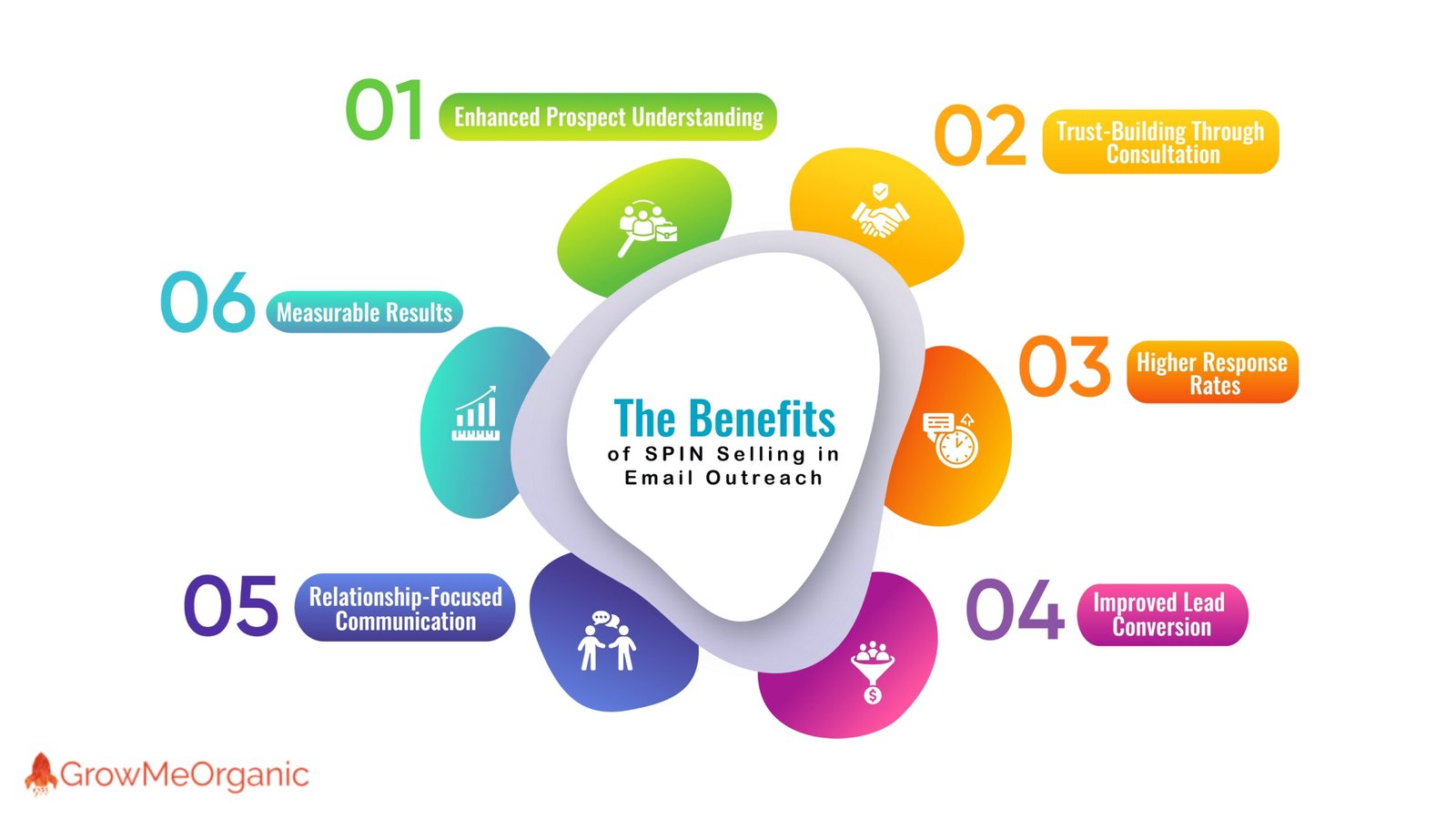
SPIN Selling emails transform standard outreach into powerful, personalized conversations that drive results. Let’s explore the distinct advantages this methodology brings to your email campaigns:
1. Enhanced Prospect Understanding
- Uncover deeper insights about your prospects through strategic questioning
- Identify specific pain points that your solution can address
- Create tailored messaging that resonates with individual decision-makers
2. Trust-Building Through Consultation
- Position yourself as a trusted advisor rather than a traditional salesperson
- Build credibility by demonstrating industry knowledge, a critical part of establishing credibility in sales
- Create meaningful dialogue that prospects want to engage in
3. Higher Response Rates
- Personalized messages that speak directly to prospect challenges
- Questions that encourage thoughtful responses
- Follow-up sequences that feel natural and valuable
4. Improved Lead Conversion
The consultative nature of SPIN Selling emails creates a foundation for successful deals:
- Prospects feel heard and understood
- Solutions are presented in the context of specific needs
- Value propositions align with actual business challenges
5. Relationship-Focused Communication
SPIN Selling emails help you:
- Create genuine connections with prospects, leading to long-term partnerships instead of one-time transactions
- Demonstrate authentic interest in their success
- Build long-term partnerships instead of one-time transactions
6. Measurable Results
- Higher open rates through targeted messaging
- Increased response rates from engaged prospects
- Better conversion rates due to aligned solution presentation
- Shorter sales cycles through focused problem-solving
The SPIN methodology applied to email outreach creates a structured yet flexible framework for engaging prospects.
By focusing on their specific situations and challenges, you’ll craft messages that capture attention and drive meaningful conversations.
Applying SPIN Techniques to Email Outreach
Let’s dive into the practical application of SPIN techniques in your email outreach campaigns. I’ve seen countless sales professionals struggle with generic templates that fail to spark meaningful conversations. The secret lies in mastering the art of research-backed, personalized communication.
1. Situation: Researching Recipients’ Current Context
Your success in SPIN selling emails starts with thorough research. Here’s how to gather valuable insights about your prospects:
LinkedIn Profile Analysis
- Recent activity and engagement patterns
- Career progression and job changes
- Published articles or shared content
- Group memberships and professional interests
- Skills endorsements and recommendations
Company Intelligence
- Recent press releases and news coverage
- Quarterly reports and financial updates
- Product launches or service expansions
- Market position and competitive landscape
- Company culture and values
Digital Footprint
- Social media presence across platforms
- Speaking engagements or webinar appearances
- Industry contributions and thought leadership
- Professional achievements and milestones
Effective Situational Questions for Email Outreach:
Direct Questions:
- “I noticed your team recently expanded into [new market]. What prompted this strategic move?”
- “Your LinkedIn post about [specific topic] caught my attention. What inspired this initiative?”
- “I saw your company’s announcement about [recent development]. How has this impacted your role?”
Implied Questions Through Statements:
- “Your recent implementation of [technology/process] aligns with the challenges we’re addressing…”
- “Based on your company’s focus on [specific goal], I thought you might be interested in…”
- “Given your team’s expansion in [area], this might be particularly relevant…”
Research Integration Tips:
1. Create a prospect research template
- Key company metrics
- Recent changes or developments
- Potential pain points
- Mutual connections or shared interests
2. Set up Google Alerts
- Track company news
- Monitor industry trends
- Follow key executives
3. Leverage Social Listening
- Track brand mentions
- Monitor competitor discussions
- Identify engagement opportunities
Remember to document your findings in your CRM or prospecting tool. This information becomes invaluable for personalizing follow-up communications and nurturing relationships throughout the sales cycle.
2. Problem: Identifying Pain Points Relevant to Your Target Audience
Let’s dive into the art of uncovering pain points that resonate with your prospects. I’ve found that BDRs and Growth Marketers share specific challenges that you can address in your email outreach:
Common Pain Points for BDRs:
- Low response rates despite high email volume
- Difficulty breaking through inbox noise
- Struggling to meet quota consistently
- Limited time for personalized research
- Inefficient lead qualification processes
Growth Marketers’ Key Challenges:
- Scaling personalized outreach campaigns
- Converting high-quality leads
- Measuring and optimizing campaign ROI
- Integration issues across outbound tools
- Resource constraints for manual outreach
To articulate these problems effectively in your emails, I recommend these proven strategies:
- Use Their Language, Mirror industry-specific terminology
- Reference familiar tools and metrics
- Include relevant benchmarks
- Paint the Picture“Are you spending hours crafting emails that disappear into the void?”
- “Is your team’s productivity dropping due to manual prospect research?”
- “What’s your strategy for scaling personalized outreach without sacrificing quality?”
- Data-Driven Problem Statements “Most sales teams waste 4+ hours daily on manual prospect research”
- “65% of BDRs struggle to maintain consistent pipeline growth”
- “Marketing teams lose 23% of leads due to poor email personalization”
The key is to present these pain points as shared challenges you understand deeply.
Your email should demonstrate that you’ve walked in their shoes and recognize the specific hurdles they face daily. This approach builds credibility and creates an immediate connection with your prospect.
Remember to tailor your problem statements based on your prospect’s role, industry, and company size. A pain point that resonates with an enterprise BDR might not impact a startup growth marketer in the same way.
3. Implication: Highlighting Consequences of Not Addressing Identified Issues
Let’s dive into the art of crafting compelling implication messages that drive action. I’ve found that prospects often need a clear picture of what’s at stake before they’re ready to make a change.
Lost Revenue Opportunities
- Delayed decision-making costs companies an average of 15-20% in potential revenue
- Market share erosion as competitors gain ground
- Missed opportunities to capture early-adopter advantages
Operational Impact
- Decreased team productivity due to manual processes
- Higher operational costs from inefficient systems
- Resource drain from maintaining outdated solutions
Here’s how to effectively communicate these implications in your emails:
Paint a Vivid Picture
Instead of: “You might lose some sales opportunities”
Write: “Each month of delay represents $50,000 in leaked revenue based on your current conversion rates”
Use Data-Driven Insights
- Industry statistics
- Competitor benchmarks
- Real customer case studies
Create Time-Sensitive Context
- Link to current market conditions
- Reference upcoming industry changes
- Highlight seasonal opportunities
Psychological Triggers That Work
- Fear of Missing Out (FOMO)
- Status quo bias
- Loss aversion
When crafting implication-focused emails, I recommend this proven structure:
- Present the identified problem
- Share specific examples of consequences
- Include relevant data points
- Connect to their business goals
- Present time-sensitive elements
Remember to maintain a consultative tone – you’re not trying to scare prospects, but rather help them understand the full scope of their challenges. This approach builds credibility while creating the necessary tension for change.
4. Need-Payoff: Framing Solutions That Align with Potential Needs and Benefits
I’ve learned that the most successful sales emails don’t just present solutions – they create value alignment between your offering and your prospect’s needs. Let me show you how to master this critical component of SPIN selling in your emails.
Creating Value Through Solution Framing
- Position your solution as a natural answer to their challenges
- Highlight specific benefits that directly address their pain points
- Demonstrate ROI potential through concrete examples
Here’s what effective need-payoff framing looks like in practice:
Instead of: “Our platform offers automated email sequences.”
Write: “You’ll save 15 hours per week on manual follow-ups, allowing your team to focus on high-value conversations.”
Customization Is Key
Your solution framing should reflect:
- Industry-specific terminology
- Relevant use cases
- Measurable outcomes that matter to their role
Building Partnership Value
Transform your emails from sales pitches into partnership opportunities:
- Share relevant case studies from similar companies
- Reference specific challenges discussed in previous communications
- Present customized implementation plans
- Include data-backed success metrics
Making It Personal
Your need-payoff message gains strength when you:
- Reference their company’s specific growth goals
- Acknowledge their unique market position
- Connect your solution to their strategic initiatives
Remember to quantify benefits whenever possible:
- Time saved
- Revenue potential
- Resource optimization
- Cost reduction
- Productivity gains
This approach positions you as a strategic partner who understands their business context and can deliver measurable value – not just another vendor pushing a product.
Best Practices for SPIN Selling Emails Success

Let’s dive into proven strategies that make SPIN-selling emails truly effective. I’ve seen countless sales teams transform their results by implementing these practices.
Personalization That Goes Beyond {{First_Name}}
- Research-Driven Customization
- Study recent company announcements
- Reference specific projects or initiatives
- Mention mutual connections or shared industry experiences
- Industry-Specific Value Props
- Tailor messaging to vertical-specific pain points
- Include relevant case studies from similar companies
- Use industry terminology appropriately
Follow-Up Strategies That Work
The 3-7-7 Follow-Up Framework
- First follow-up: 3 days after the initial email
- Second follow-up: 7 days after the first follow-up
- Final attempt: 7 days after the second follow-up
Content Variation Techniques
- Share new insights in each follow-up
- Add value through relevant resources
- Reference previous communications naturally
Timing and Frequency Best Practices
- Send emails during business hours in the recipient’s timezone
- Avoid Monday mornings and Friday afternoons
- Space follow-ups appropriately to avoid appearing desperate
Automation Without Losing the Human Touch
Smart Sequence Design
- Set up behavior-based triggers
- Create conditional paths based on engagement
- Include manual check-in points for high-value prospects
Engagement Signals to Monitor
- Email opens and click-through rates
- Reply sentiment analysis
- Website visits post-email
Writing Style Guidelines
Keep It Concise
- 3-5 sentences per paragraph
- One clear call-to-action
- Bullet points for complex information
Professional Yet Personal
- Use a conversational tone
- Share relevant personal experiences
- Include social proof naturally
Subject Line Optimization
- Keep it under 50 characters
- Include company name when relevant
- Test different approaches:
- Question-based
- Problem-focused
- Benefit-oriented
These practices help maintain a balance between persistence and respect for your prospect’s time. By implementing these strategies, you’ll create email sequences that nurture relationships while moving deals forward effectively.
Measuring Success: Utilizing Analytics To Refine Your Email Strategies
Data-driven decision making separates successful SPIN selling email campaigns from shots in the dark. Let’s dive into the metrics that matter and how to use them effectively.
Key Performance Indicators to Track:
- Open rates: Measure subject line effectiveness
- Click-through rates: Gauge content engagement
- Reply rates: Assess prospect interest
- Conversion rates: Track successful outcomes
- Time-to-response: Understand prospect behavior
Your email analytics tell a story about prospect engagement. A low open rate might signal weak subject lines, while poor click-through rates could indicate misaligned content.
By monitoring these metrics, you’ll spot patterns in what resonates with your audience.
Advanced Analytics Insights:
- A/B test different SPIN question formats
- Track engagement patterns across industries
- Monitor response timing for optimal sending
- Analyze successful vs. unsuccessful sequences
I’ve found that personalizing emails based on analytics insights can boost response rates by 30-40%.
When you notice certain problem questions generating higher engagement, double down on those approaches in future campaigns.
Action Steps for Analytics-Based Optimization:
- Set baseline metrics for each SPIN component
- Track performance weekly
- Identify top-performing email templates
- Refine messaging based on engagement data
- Scale successful approaches across campaigns
Remember to segment your data by prospect type, industry, and company size. Different audiences respond differently to SPIN techniques – what works for enterprise prospects might fall flat with SMBs.
Avoid Common Pitfalls In Email Outreach That Can Sabotage Your Efforts

I’ve seen countless sales professionals stumble into email outreach pitfalls that derail their SPIN selling efforts. Let’s tackle these head-on to protect your success rate.
1. Generic Mass Emails Kill Response Rates
Avoid these common mistakes in your email outreach:
- “I hope this email finds you well” – Delete this from your vocabulary
- “[Company Name]” placeholders left unfilled
- Copy-paste templates without customization
- Lack of research-backed context about the recipient’s situation
2. Poor Question Sequencing
Be mindful of the following issues with your questioning technique:
- Jumping straight to solution-focused questions
- Missing the crucial problem exploration phase
- Asking closed-ended questions that halt conversation
- Failing to build upon previous interactions
3. Personalization Mistakes to Avoid
Ensure you’re personalizing your emails effectively by avoiding these errors:
- Using only first names without company context
- Ignoring the recipient’s industry challenges
- Missing opportunities to reference recent company news
- Failing to acknowledge their specific role/responsibilities
4. Follow-Up Failures
When following up, make sure you’re not making these mistakes:
- Sending identical follow-up messages
- Not spacing follow-ups appropriately
- Lacking value-add in subsequent communications
- Forgetting to reference previous touchpoints
5. Technical Errors That Cost Credibility
Double-check your technical details to avoid these credibility-damaging errors:
- Broken merge fields
- Incorrect company information
- Outdated data from LinkedIn
- Wrong name spellings
The key to avoiding these pitfalls lies in thorough preparation.
I recommend creating a pre-send checklist that includes verification of all personalization elements, question sequencing, and technical components. This systematic approach helps maintain the integrity of your SPIN selling strategy while ensuring each email delivers maximum impact.
Closing More Deals With SPIN Selling Emails
SPIN selling emails transform your outreach from generic pitches into meaningful conversations that drive results. The proof is in the numbers – sales teams using SPIN techniques report up to 35% higher response rates and a 25% increase in closed deals.
Here’s what you can achieve by implementing SPIN selling in your email strategy:
- Higher engagement rates through personalized, research-backed outreach
- Stronger relationships built on understanding your prospects’ needs
- Increased conversion rates by addressing specific pain points
- Better ROI from your email campaigns
I’ve seen countless sales teams revolutionize their results after adopting SPIN selling principles in their emails. The key is to start small – pick one element of SPIN selling and incorporate it into your next email campaign. Test different approaches, measure your results, and refine your strategy based on what works best for your audience.
Ready to transform your email outreach? Start by:
- Researching your next prospect’s situation
- Crafting problem-focused questions
- Building implications into your message
- Highlighting need-payoff scenarios
Your prospects are waiting for emails that truly speak to their needs. Take action now – implement SPIN selling techniques in your next email campaign and watch your close rates soar.
FAQs (Frequently Asked Questions)
What is SPIN Selling?
SPIN Selling is a consultative sales approach developed by Neil Rackham that focuses on understanding the customer’s Situation, identifying their Problems, exploring the Implications of those problems, and discussing the Need-Payoff for potential solutions.
How can SPIN Selling techniques enhance email outreach?
By applying SPIN Selling techniques to email outreach, sales professionals can effectively engage prospects by addressing their specific needs through effective questioning, ultimately leading to improved response rates and higher conversion rates.
What are the key components of SPIN Selling?
The key components of SPIN Selling include Situation Questions to understand the context, Problem Questions to identify pain points, Implication Questions to highlight the consequences of inaction, and Need-Payoff Questions to frame solutions that align with the prospect’s needs.
What strategies can I use to research recipients before sending emails?
Effective strategies for researching recipients include reviewing their LinkedIn profiles, staying updated on company news, and gathering insights that help tailor your emails to their current situation and specific needs.
What are some best practices for follow-up emails in SPIN Selling?
Best practices for follow-up emails include maintaining engagement without overwhelming prospects by using automated follow-ups judiciously, personalizing content with first/last names, and ensuring continuity from previous interactions.
How can I measure the success of my email outreach efforts?
You can measure the success of your email outreach by utilizing analytics tools to track performance metrics such as open rates, click-through rates, and reply rates. This data allows you to refine your future email strategies based on what resonates with your audience.
About Post Author
Gopu Shivashankaran
Head of Sales @ GrowMeOrganic | Growth Hacking | B2B Saas | Prospecting and Cold Outreach Systems



